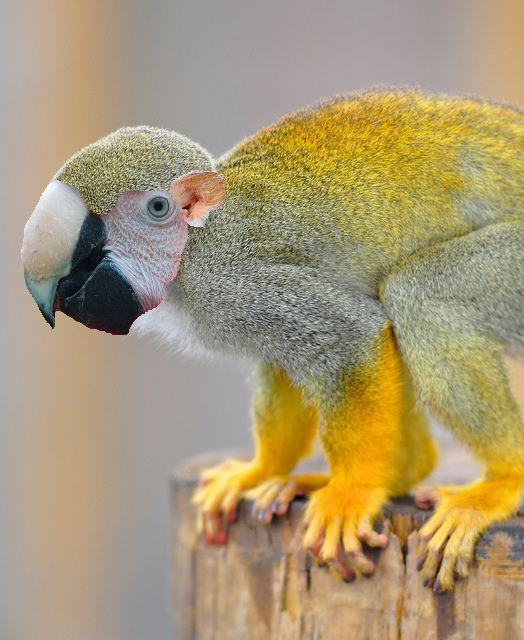Beaked Monkey
| Beaked Monkey | |
|---|---|
 Psittarhynchus fructophagii | |
| Base Information | |
| Classification | Herbivore/intermittent |
| Terrain | {{{terrain}}} |
| Locomotion | Walk |
| Size | Typical |
| Speed | Crawl |
| Strength | Standard |
| Social Structure | Single or Pair |
| Weapons | None |
| Armor | {{{armor}}} |
| Body Structure | |
| Symmetry | Bilateral |
| Head/Torso | Head with brain/senses |
| Limbs & Manipulators | 2 arms with paws, 2 legs |
| Tail | 1 tail |
| Skeleton | Bony interior |
| Internal Fluids | Blood |
| Skin | Furry pelt |
| Natural Weapons | None |
| Body Shape | |
| Size | Typical |
| Stance | Horizontal |
| Length/Height | 0.75 m |
| Body Profile | Thin |
| Weight | 2.9 kg |
| Details | |
| Edibility | No |
| Training Difficulty | Yes |
| Source | |
| Homeworld | Unknown |
| Multi-world | Yes |
| Canon | No |
| Reference | No results |
Beaked Monkey (Psittarhynchus fructophagii) or Beakers (as they are sometimes called) are common on many worlds, both in the wild and in captivity. In addition, they are found on many starships as pets.
Their planet of origin is not known, but the animals can be documented as far back as far as 300 years pre-lmperial, with a range almost as widespread as at the present.
Physiology & Ecology
Beaked monkeys typically weigh from 2 to 3 kilograms, and measure 60 to 75 cm in length, half of which is generally taken up by the tail. Tails are sometimes bobbed on animals kept aboard spacecraft. Beakers are covered by a short fur, most commonly brown or gray. Black is rare, and white extremely so. The skeleton and musculature follow typical Terran vertebrate norms. Respiration is accomplished by the usual paired lung arrangement, the circulatory system is closed and the heart four chambered, making the animal very similar to certain small Terran mammals such as the Squirrel Monkey.
The animal's most notable feature, the beak, is formed of two bony projections from the palate and mandible, covered by horny bio-polymer. The lower third of the esophagus is extremely heavily muscled and lined with a number of tooth-like grinding structures, which break swallowed food into fragments small enough to be digested readily.
Life Cycle
No information yet available.
Diet & Trophics
In the wild, the beaker is arboreal, and is thought to have originally subsisted on a diet of hard-shelled nuts and seeds, although specimens have been observed eating insects and other small animals. In captivity, beakers thrive on almost any available type of human food.
History & Background
The animals are quite popular as pets on starships because of their gregarious affection to almost all humans, their intelligence and their scrupulous cleanliness.
Some individuals are rumored to act as a booster for certain psionic activities, but this last ability has not been proven to the satisfaction of most authorities.
Travellers' Aid Society Advisory
No information yet available.
References and contributors
- Citation Missing - Journal of the Travellers' Aid Society 3
- Marc Miller. T5 Core Rules (Far Future Enterprises, 2013), 589.
- Illustration:

- Illustration:

- Illustration:
